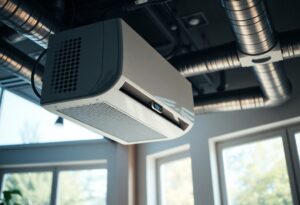Top 5 Benefits of Regular Air Quality Tests for Your Home
Indoor air quality (IAQ) is a critical aspect of a healthy living environment. Often overlooked, poor air quality can have significant impacts on your health, safety, and overall well-being. Regular air quality tests are essential for identifying and mitigating indoor pollutants. In this blog post, we’ll explore the top benefits of conducting regular air quality tests in your home, explain why you should have an air quality test, describe what happens during the testing process, and discuss the suggestions you may receive for improving your indoor air quality.
Why Should You Have an Air Quality Test?
1. Health Improvement
Poor indoor air quality can lead to various health issues, including allergies, asthma, respiratory infections, and other chronic conditions. By regularly testing your air quality, you can identify harmful pollutants such as mold, dust, pollen, pet dander, and volatile organic compounds (VOCs). Addressing these issues can significantly improve your health and the health of your family members.
2. Increased Safety
Certain indoor pollutants, such as carbon monoxide and radon, can be extremely dangerous and even life-threatening. Regular air quality tests can detect these hazardous substances early, allowing you to take immediate action to mitigate their effects and ensure the safety of your home.
3. Enhanced Comfort
Good air quality contributes to a more comfortable living environment. It can reduce unpleasant odors, improve humidity levels, and create a fresher atmosphere in your home. This can enhance your overall comfort and quality of life.
4. Long-term Savings
Identifying and addressing air quality issues early can prevent more severe problems down the line, such as extensive mold remediation or medical expenses due to health complications. Regular testing can save you money in the long run by preventing costly repairs and health care costs.
5. Compliance and Peace of Mind
In some regions, regular air quality testing is required to comply with local regulations, especially if you rent out your property or run a business from home. Conducting regular tests ensures you meet these regulations and provides peace of mind knowing your living environment is safe and healthy.
Looking for Jobs in HVAC-R and Plumbing or Want to Post Jobs, Get them on the HvacJobsCenter
What Happens During an Air Quality Test?
1. Initial Assessment
A professional air quality technician will start with an initial assessment of your home. They will ask about any specific concerns you have, such as mold growth, pet dander, or lingering odors.
2. Sampling
The technician will take samples from various areas in your home using specialized equipment. This may include air sampling, surface sampling, and collecting dust or mold spores. They might use devices like air pumps, particle counters, or moisture meters to gather data.
3. Analysis
The collected samples are sent to a laboratory for analysis. The lab will identify the presence and concentration of various pollutants, including allergens, VOCs, mold spores, and other harmful substances.
Tip of the Day
Ensure your family breathes clean air with professional air quality tests for your home! Detect pollutants and allergens to improve your indoor environment.
👉 Shop for options today and breathe easier tomorrow. Take the first step towards a healthier home environment!
4. Report Generation
Once the analysis is complete, the technician will provide you with a detailed report outlining the findings. This report will include information about the types and levels of pollutants detected, along with potential sources and areas of concern.
Tip of the Day
Will You Be Given Suggestions on How to Have Better Indoor Air Quality After an Air Quality Test?
Yes, following an air quality test, you will typically receive comprehensive suggestions on how to improve your indoor air quality. These recommendations may include:
1. Ventilation Improvements
- Increase Natural Ventilation: Open windows and doors regularly to allow fresh air to circulate.
- Install Exhaust Fans: Use exhaust fans in bathrooms and kitchens to remove moisture and pollutants.
- Upgrade HVAC Systems: Consider upgrading your HVAC system to one with advanced filtration and ventilation capabilities.
2. Air Purifiers
- Use HEPA Filters: Invest in air purifiers with HEPA filters to capture airborne particles and allergens.
- Activated Carbon Filters: Use air purifiers with activated carbon filters to remove odors and VOCs.
3. Regular Cleaning
- Dust and Vacuum Regularly: Use a vacuum with a HEPA filter to remove dust and allergens from carpets and upholstery.
- Wash Bedding: Clean bedding and curtains frequently to reduce dust mites and allergens.
- Clean Air Ducts: Have your air ducts cleaned to remove accumulated dust and debris.
4. Humidity Control
- Use Dehumidifiers: Maintain indoor humidity levels between 30% and 50% to prevent mold growth.
- Fix Leaks: Repair any leaks promptly to prevent water damage and mold development.
5. Chemical Management
- Use Low-VOC Products: Choose low-VOC paints, finishes, and cleaning products.
- Store Chemicals Safely: Keep household chemicals and cleaners in well-ventilated areas and away from living spaces.
6. Pet Management
- Groom Pets Regularly: Bathe and groom your pets frequently to reduce dander.
- Clean Pet Areas: Wash pet bedding and toys regularly to minimize allergens.
7. Smoking Restrictions
- Smoke Outside: Encourage smoking outside to prevent indoor pollution.
- Use Air Purifiers: Place air purifiers with activated carbon filters in areas where smoking occurs.
Conclusion
Regular air quality tests are essential for maintaining a healthy, safe, and comfortable home environment. By identifying and addressing indoor pollutants, you can significantly improve your health and well-being. Following an air quality test, you will receive actionable recommendations to enhance your indoor air quality. Whether you have pets, smoke, or simply want to ensure the best air quality for your family, these tests are a vital step in creating a cleaner, healthier home. Don’t wait—schedule your air quality test today and start breathing easier at home!
Follow Us on Google Chrome
- To get started, switch to Google Chrome Browser
- Already on our site
- Top right, tap the 3 dots
- Bottom right, tap follow
- You are done.
Learn more and join our mailing list.
This post has been written by Team HVAC Talk Magazine. Stay informed and connected with the latest in HVAC—join us for expert advice, troubleshooting tips, and news updates. Don’t miss out, follow us now! #HVACExperts #HVACTips #StayInformed #HVACProTalk








